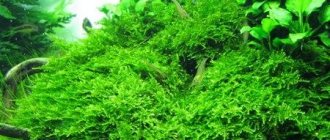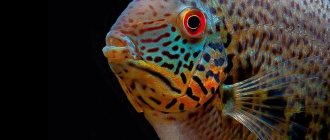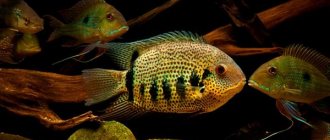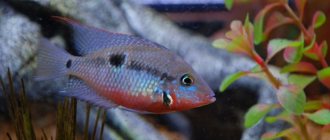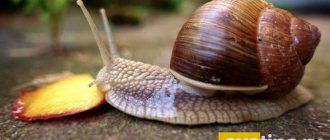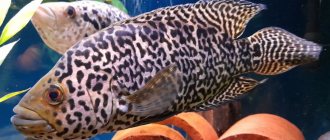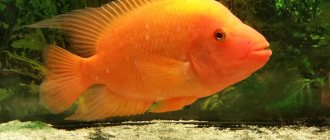In aquarium keeping, as in any other hobby, there are fans of both small species of fish and those who prefer to keep large species. Large cichlids are usually preferred, with red-spotted severum being particularly popular. This cichlid has an attractive color, and what is especially important for beginner aquarists is that it is unpretentious to the conditions of its keeping. And all this is complemented by its interesting behavior, because the cichlid demonstrates meaningful behavior, which is rarely characteristic of fish.
Description
Severums, like real discus, have a high and laterally compressed body, with pointed anal and caudal fins. This is a small cichlid (relative to other cichlases), reaching 20 cm in nature, and about 15 cm in an aquarium.
Life expectancy is about 10 years.
Natural coloring is a greenish body with a golden-yellow belly. Juveniles are distinguished by their inconspicuous coloring, with eight dark stripes running along their dark body, which disappear as the fish matures.
As already mentioned, now there are many different color variations, but the most popular and beautiful are red pearl and blue emerald.
Kinds
Under natural conditions, the color of false discus is variable and can vary depending on where the cichlid lives .
Aquarium specimens are much brighter in color than their wild counterparts, and finding an individual with a natural color can be difficult. We list the most common varieties.
Red-shouldered rottail
This fish has a large bright red-orange spot behind the head line, which became the basis for the name severum.
The color is greenish-olive, the fins are orange with red streaks.
Severum golden (Gold)
This representative of severums is more similar to discus than others. The body of the fish is large, almost flat and very high. The color is golden yellow. Males have an orange spot on their head.
Red Pearl, Red Spot
The fish is notable for its unusual speckled color: small round spots are scattered on the yellow body, for which it received its second name - red-spotted severum.
Green Guyana
Otherwise, Severum Guyana. It is distinguished by a yellowish-green color with black specks, and in young animals vertical stripes are clearly visible.
Blue emerald (Santarem)
The color of this fish is blue or blue with a slight green tint; vertical stripes of a dark shade are clearly visible on the body, which will become spots with age.
Red-bellied (Mouthbreeder)
The color is olive with a golden tint, there is a large red spot on the abdomen. There is a dark spot in the tail part.
Cichlasom differs from the rest in its behavior during spawning: for example, the female carries eggs in her mouth until the fry appear.
Inirida severum
This cichlazoma is named after the left tributary of the Orinoco River - Inirida. The body of the severum is slightly higher than that of other varieties, the color is gray-brown with a clear green tint and an olive tint.
Brown spots are easily visible on the sides, and spots of a dark yellow hue are visible closer to the abdomen.
Feeding
The fish are omnivores and will eat all types of aquarium fish food. The basis of feeding can be made from sinking tablets for large cichlids (preferably containing fiber, such as spirulina).
Additionally, provide live or frozen food: both large ones - earthworms, shrimp, fish fillets, and small ones - tubifex, bloodworms, gammarus.
It is especially important to feed with plant foods, since fish in nature mainly consume them. This can be either special food or pieces of vegetables - cucumber, zucchini, lettuce.
There is no need to feed mammalian meat such as beef heart frequently. Such meat is poorly digested by the fish’s stomach and leads to obesity and disease.
It is better to feed cichlase in small portions twice a day, being careful not to overfeed, as the fish are prone to gluttony.
How is a male different from a female?
Sexual differences between individuals are clearly visible.
First of all, they talk about size - the male is usually larger than the female and has a brighter color.
The male has much larger dorsal and anal fins than the female. Their tips form so-called braids.
During the mating season, the male develops an anal tubercle similar to a cone. Such a formation in a female is like a truncated pyramid.
Keeping in an aquarium
Severums are fairly small cichlids, but relative to other fish they are still large. For maintenance you need an aquarium of at least 200 liters, and the larger it is, the calmer the fish will be.
They love clean water and a slight current, which can be created using an external filter. Be sure to regularly replace the water with fresh water and siphon the soil to remove any remaining feed.
Try to light the aquarium dimly; you can let floating plants float to the surface of the water. The fish is shy and can jump out of the water when frightened.
The easiest way is to set up an aquarium in the form of a South American river biotope. Sandy soil, large stones and driftwood - this is the environment where cichlid will feel ideal. The picture is complemented by fallen leaves at the bottom, for example, oak or beech.
Separately, we note that severums are not very friendly with plants; some lovers manage to keep them with tough species, but mostly the plants face an unenviable fate; they will be destroyed.
False discus adapt well to different water parameters in the aquarium, but the ideal would be: temperature 24-28 ° C, pH: 6.0-6.5, 4 - 10 dGH.
Diseases
The aquarium fish severum has a fairly strong body and is not too susceptible to various diseases. They usually occur if the pet is kept in poor conditions, due to which its immunity has decreased.
These animals are more sensitive to the purity of water. If there is a high content of nitrogen-containing substances in it, then this is immediately reflected in the behavior of the individual. Therefore, if you notice these changes, you need to immediately change the water and clean the soil and filter.
Also on forums, the owners of these fish sometimes write that they are sick with “semolina”. This is an infectious disease that appears as white spots all over the body. To cure ichthyophthyriosis, you need to immediately raise the water temperature to 30 degrees and turn on aeration. If the situation does not improve, then you will have to use medications. As a rule, methylene blue, antipar, metronidazole, etc. are used.
The Severum fish has a fairly strong body and is not too susceptible to various diseases. But due to sensitivity to water, the immune system may be weakened, which can lead to a disease such as ichthyophthyriosis.
Compatibility
Should be kept with fish of similar behavior and size. Small fish are perceived as food. Although American cichlids are less aggressive than African cichlids, it is still important to keep the aquarium spacious.
Then they will have their own territory to protect. Their own place and large neighbors significantly reduce the aggressiveness of cichlids.
They get along well with other small cichlids - black stripe, meek, bee. The same with catfish - veiled synodontis, plecostomus, sacbranchial.
Nutrition
For feeding cichlases, food of both plant and animal origin is suitable .
Of course, as a predator, severum prefers organic food (bloodworms, tubifex, shrimp), but its diet should also include herbal supplements (nettle, lettuce, dandelion), previously scalded with boiling water.
If the diet consists only of dry food, you need to choose those that contain spirulina.
Breeding
Like many cichlids, false discus care for their offspring and nurse the fry. The pair is formed for a long time, and since it is often very difficult to distinguish a male from a female, they take 6-8 fry and raise them together, the fish will choose a mate for themselves.
Severums can spawn in different water parameters, but are most successful in soft water, with a pH around 6 and a temperature of 26-27 °C. Also, the beginning of reproduction is facilitated by abundant changes of fresh water.
Very often, severums spawn in the same aquarium in which they live, but you need to take into account that during this period their aggressiveness increases. They like to lay their eggs on a flat stone or driftwood. The female lays about 1000 eggs, the male fertilizes them and both parents take care of the eggs and fry.
After the fry swims, the parents protect it, allowing the fry to feed on artemia nauplii, artificial food, and microworms.
The fry can also peck a special secretion from the skin of their parents, which they secrete specifically for feeding. Parents can care for the fry for up to 6 weeks.
Interesting things about severums
— Producers (male and female) are able to secrete a special secretion from the epithelium on which the juveniles feed. Therefore, as a rule, there are no problems with raising severum juveniles. However, sometimes this may not happen due to the fish’s adaptation to aquarium life; parents are simply too lazy to feed their babies.
— Cichlazomas severum are capable of forming not only opposite-sex pairs, but also monogamous ones (two females). The eggs of such producers, accordingly, remain unfertilized.
Reviews
I bought two bright yellow cichlids. I was pleasantly surprised by the calm behavior of the fish. They get along well with angelfish and there are no conflicts with neighbors. Irina
I've been keeping severums for a long time. There were several, they even multiplied. But other fish ate the offspring. Now there are only 2 individuals left, but it seems they are same-sex and will not reproduce. Andrey, Voronezh, 38 years old
I have had severums for about 5 years now. There were seven of them, 3 fish remained, the rest died, I don’t know the reason. I want to buy more. There is no hassle with them, the only problem is that they destroy living plants, so I bought them artificial ones. Natalya, 56 years old, Barnaul
3 severums live in my 250 liter aquarium along with other fish. I feed mostly live food. Sometimes they make a guttural sound that can be heard if you stand next to an aquarium. They are easy to care for, although they do chew on plants. Mikhail, Kurgan, 46 years old
Notes
Severum (Heros efasciatus) is one of the most popular and easily available cichlids in the aquarium hobby, however, not everyone realizes that these fish can reach quite large sizes and are therefore not suitable for all aquariums. The fish is typically sold in the standard juvenile gray coloration.
Severum is a great fish for a South American community aquarium, as long as there is no fish there yet that is small enough for them to eat. They grow quite quickly, so should be placed in a fairly large aquarium from the very beginning.
Range and Habitat
South America: Widely distributed in tributaries of the Amazon River, mainly in the Ucayali River in Peru and the Solimões River in Brazil, it has also been seen in the Xingu River.
The most common habitats are in deeper, calmer waters with lots of submerged tree roots and branches.
